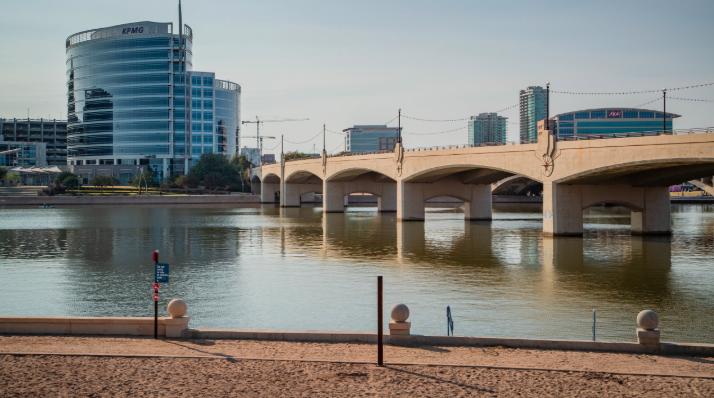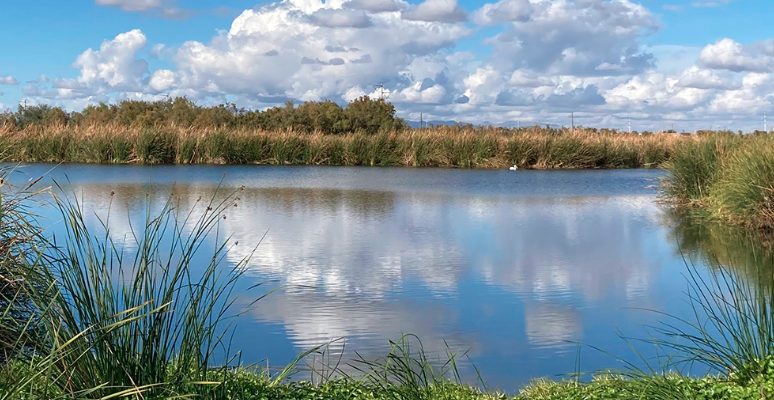Onk Akimel Ha Ñukutham: Water Is Life, and Memory, and Resistance
“Every map you’ve seen today was drawn by power. Every dam was a decision. Every dry riverbed is an archive of harm and every act of restoration is an act of rebellion. We aren’t here to admire nature. We’re here to remember that we are nature. The river’s future is our future. And the only way forward is together.”
On October 4th, 2025, the AZ(LAND) River Systems Tour, hosted with the Protectors of the Salt River, was a journey through the stolen, dammed, buried, and reborn arteries of the Salt and Gila Rivers. It was a day of story, solidarity, and confrontation with the truth of what the Valley of the Sun has built on Indigenous land and water and what it might mean to choose repair.
The groups gathered at sunrise in South Phoenix, standing on the land of what was once a mile-wide, flowing river the Onk Akimel, “the Salt River.” Our guide, began with a charge that silenced the hum of the nearby freeway: “Before you get on the bus, feel the ground. Listen for what’s missing.” The sound of rushing water, the shade of cottonwoods, the laughter of families fishing all gone. The group was told to close their eyes and imagine the ancient canal systems of the Huhukam people, who made this desert bloom without draining it. Then came the turning point what the Protectors’ digital zine names “the colonial disruption”: a century of dams, diversions, and dispossession that turned the river from a sacred lifeline into an industrial sacrifice zone.
The first stop, Tempe Town Lake, was a study in contradictions. We stood beneath a skyline of glass towers reflecting the morning light off a lake filled with imported Colorado River water, a manufactured oasis created by damming a dry riverbed. Some call it “a mirage of progress,” built on erasure. The original Mexican barrio, La Misión, was bulldozed for this “revitalization.” “This is what environmental injustice looks like, when a river becomes a prop for capital instead of a home for community.” The group passed around tablets showing The Geography of Despair and Fuerte’s Environmental Racism in South Phoenix research and art that trace the policies that weaponized geography to separate.
Heading south, the tour crossed into the Gila River Indian Community, where the water’s story turns toward resilience. Standing at the MAR-5 Aquifer Recharge Site, we learned how the Akimel O’otham fought for a century to reclaim the water stolen from them how they refused relocation, organized politically, and negotiated the 2004 Arizona Water Settlements Act to turn “paper water” into “wet water.” The hum of the pumps seemed to carry the words of a young community member: “Our ancestors’ canals are still here, and now we’re putting the water back in them.” This was restoration not as metaphor but as praxis, a physical, spiritual, and legal act of decolonization.
Further west, at the Great Bend of the Gila, participants walked quietly among ancient petroglyphs, guided to “listen to the stones.” The Protectors described these carvings as storywork, sacred communication across time and connected their preservation to modern policy efforts to designate the area as a National Monument co-managed by tribal nations. “This is what decolonizing conservation looks like,” one storyteller shared. “It’s restoring authority to the original stewards.”
The day ended at Tres Rios Wetlands, a site where treated wastewater from Phoenix’s sewers has become a lush, breathing ecosystem. Herons glided over cattails, the air smelled faintly of wet earth, and the temperature dropped several degrees. “This,” said a volunteer, “is what repair looks like when power changes hands. When waste becomes water. When care replaces extraction.” Tres Rios mirrored the Protectors’ own work, the hundreds of Sunday mornings spent pulling invasive stinknet weeds along the dry riverbed, the meals cooked by Indigenous chefs to feed volunteers, the storytelling circles that heal trauma by replanting memory. The same logic runs through it all: healing the land is inseparable from healing the people.
The tour ended where it began back at the Audubon Center, but with changed eyes and hearts. The closing words came from one of the organizers:
“We have traveled along a ghost river, a commodified river, a sacred river, and a resurrected river. Each shows us a different truth about who we are as a society and who we could become. The Protectors of the Salt River believe that the health of the river is a mirror for the health of our communities. We are restoring not only the river, but our relationships with each other.”
Participants left with a packet of digital resources the Protectors’ Digital Zine, links to CAP LTER Virtual Field Trips, and Archaeology Southwest’s Cultural Site Guides but perhaps the more lasting takeaway was a felt sense of belonging. The tour was an act of remembering that the land is alive, and that stewardship is a way of life.
The Protectors of the Salt River continue their work each week gathering volunteers for Stinknet Pull Days at the Nina Mason Pulliam Rio Salado Audubon Center, organizing monthly bike rides that trace the river’s path through the city, and building partnerships across planning, policy, and science to transform the Valley’s extractive legacy into a living ecology of justice.
Support their work. Visit protectorsofthesaltriver.com. Follow @protectorsofthesaltriver. Or show up in person — gloves on, heart open — and put your hands in the soil where the river once ran.
“Water remembers. It’s only waiting for us to remember too.”






